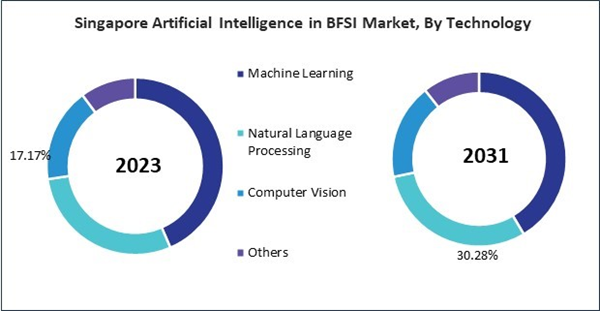The Asia Pacific Artificial Intelligence in BFSI Market would witness market growth of 33.2% CAGR during the forecast period (2024-2031).
The China market dominated the Asia Pacific Artificial Intelligence in BFSI Market by Country in 2023, and would continue to be a dominant market till 2031; thereby, achieving a market value of $18,894.8 million by 2031. The Japan market is registering a CAGR of 32.4% during (2024 - 2031). Additionally, The India market would showcase a CAGR of 34% during (2024 - 2031).
AI algorithms analyze customer data, transaction history, and behavior patterns to offer personalized financial recommendations, product recommendations, and targeted marketing campaigns. By understanding customer preferences and financial goals, BFSI organizations can tailor offerings to meet individual needs. AI algorithms sift through vast customer data to identify patterns and trends, enabling BFSI institutions to segment their customer base effectively.
By categorizing customers based on demographics, spending habits, risk tolerance, and life events, organizations can target specific segments with personalized offerings tailored to their unique needs and preferences. Whether it's suggesting investment portfolios, insurance coverage, or loan options, AI algorithms leverage predictive analytics to match customers with the most suitable financial products and services.
Fintech companies in India are leveraging AI algorithms to revolutionize the lending landscape by offering alternative lending solutions and innovative credit scoring models. AI-driven credit assessment platforms analyze non-traditional data sources such as digital footprints, social media profiles, and transaction histories to evaluate creditworthiness and assess risk. As per the Indian Brand Equity Foundation, by 2025, the Indian fintech sector is anticipated to be worth $150 billion. India possesses the third most extensive fintech ecosystem. India is among the fintech sectors with the most rapid expansion. There are over 2,000 DPIIT-recognized Financial Technology (FinTech) businesses in India, and the number is rapidly increasing. Thus, the growing digitalized banking sector in Asia Pacific will drive the expansion of the regional market.
Based on Offering, the market is segmented into Software, Hardware, and Services. Based on Technology, the market is segmented into Machine Learning, Natural Language Processing, Computer Vision, and Others. Based on Solution, the market is segmented into Chatbots, Fraud Detection & Prevention, Customer Relationship Management, Data Analytics & Prediction, Anti-Money Laundering, and Others. Based on countries, the market is segmented into China, Japan, India, South Korea, Singapore, Malaysia, and Rest of Asia Pacific.
The China market dominated the Asia Pacific Artificial Intelligence in BFSI Market by Country in 2023, and would continue to be a dominant market till 2031; thereby, achieving a market value of $18,894.8 million by 2031. The Japan market is registering a CAGR of 32.4% during (2024 - 2031). Additionally, The India market would showcase a CAGR of 34% during (2024 - 2031).
AI algorithms analyze customer data, transaction history, and behavior patterns to offer personalized financial recommendations, product recommendations, and targeted marketing campaigns. By understanding customer preferences and financial goals, BFSI organizations can tailor offerings to meet individual needs. AI algorithms sift through vast customer data to identify patterns and trends, enabling BFSI institutions to segment their customer base effectively.
By categorizing customers based on demographics, spending habits, risk tolerance, and life events, organizations can target specific segments with personalized offerings tailored to their unique needs and preferences. Whether it's suggesting investment portfolios, insurance coverage, or loan options, AI algorithms leverage predictive analytics to match customers with the most suitable financial products and services.
Fintech companies in India are leveraging AI algorithms to revolutionize the lending landscape by offering alternative lending solutions and innovative credit scoring models. AI-driven credit assessment platforms analyze non-traditional data sources such as digital footprints, social media profiles, and transaction histories to evaluate creditworthiness and assess risk. As per the Indian Brand Equity Foundation, by 2025, the Indian fintech sector is anticipated to be worth $150 billion. India possesses the third most extensive fintech ecosystem. India is among the fintech sectors with the most rapid expansion. There are over 2,000 DPIIT-recognized Financial Technology (FinTech) businesses in India, and the number is rapidly increasing. Thus, the growing digitalized banking sector in Asia Pacific will drive the expansion of the regional market.
Based on Offering, the market is segmented into Software, Hardware, and Services. Based on Technology, the market is segmented into Machine Learning, Natural Language Processing, Computer Vision, and Others. Based on Solution, the market is segmented into Chatbots, Fraud Detection & Prevention, Customer Relationship Management, Data Analytics & Prediction, Anti-Money Laundering, and Others. Based on countries, the market is segmented into China, Japan, India, South Korea, Singapore, Malaysia, and Rest of Asia Pacific.
List of Key Companies Profiled
- Microsoft Corporation
- IBM Corporation
- Palantir Technologies Inc.
- Salesforce, Inc.
- SAP SE
- Baidu, Inc.
- Google LLC (Alphabet Inc.)
- Amazon Web Services, Inc. (Amazon.com, Inc.)
- Oracle Corporation
- Intel Corporation
Market Report Segmentation
By Offering- Software
- Hardware
- Services
- Machine Learning
- Natural Language Processing
- Computer Vision
- Others
- Chatbots
- Fraud Detection & Prevention
- Customer Relationship Management
- Data Analytics & Prediction
- Anti-Money Laundering
- Others
- China
- Japan
- India
- South Korea
- Singapore
- Malaysia
- Rest of Asia Pacific
Table of Contents
Chapter 1. Market Scope & Methodology
Chapter 2. Market at a Glance
Chapter 3. Market Overview
Chapter 4. Competition Analysis - Global
Chapter 5. Asia Pacific Artificial Intelligence in BFSI Market by Offering
Chapter 6. Asia Pacific Artificial Intelligence in BFSI Market by Technology
Chapter 7. Asia Pacific Artificial Intelligence in BFSI Market by Solution
Chapter 8. Asia Pacific Artificial Intelligence in BFSI Market by Country
Chapter 9. Company Profiles
Companies Mentioned
- Microsoft Corporation
- IBM Corporation
- Palantir Technologies Inc.
- Salesforce, Inc.
- SAP SE
- Baidu, Inc.
- Google LLC (Alphabet Inc.)
- Amazon Web Services, Inc. (Amazon.com, Inc.)
- Oracle Corporation
- Intel Corporation
Methodology

LOADING...









